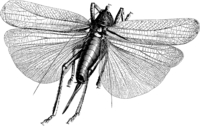

| FALL 2005 CONTENTS |
|
| Using Toy Insects in the Classroom |

|
| USING
TOY INSECTS IN THE CLASSROOM |
|
In 2004, the University of Kentucky Department of Entomology worked with the American Printing House for the Blind, the Kentucky Department of Education, and the Crowe's Chase Advisory Board to create a low-vision insect guide called "Common Insects and Their Relatives Found on Kentucky Trees." The goal of this guide is to allow students to study insects using the sense of touch. We based the guide on a set of toy insects sold by the Discovery Channel called "Bugs Party Case" available on Amazon.com. These are fairly accurate toys, with the correct number of legs, antennae, and other body parts. Using the guide, students can examine the toys to understand the structures and functions on each creature and to learn about identification. This is just a guide, but a clever instructor can create any number of activities based on the guide and the toy insects. Although the guide was designed with low-vision and blind students in mind, it works well as a way to introduce all young students (elementary and middle school) to insects. Braille and low-vision versions
of the guide were printed by the American Printing House for the blind.
Many of these documents were given to the Kentucky School For
the Blind in Louisville, KY. If you are a Kentucky teacher who
works with blind or low-vision students, contact us (blaken@uky.edu)
and we will see if it is possible to get you copies of these documents.
The low-vision version of the document, which includes pictures
which could not be printed in the Braille version, is available online
at: |
|
 Toy Ant: an image from the guide to toy bugs (B. Newton, 2004) |
|
KENTUCKY STUDENTS INVESTIGATE
LADY BEETLES |
| Beginning in Fall '05, middle- and high-school students in 3 Kentucky counties began investigating the Asian Multicolored Lady Beetle and a fungus which infects the beetle. The Asian Multicolored Lady Beetle, Harmonia axyridis, is an exotic species which was brought to North America to eat aphids and other pests. The beetle does a great job of eating pests, but it also swarms inside homes in huge numbers in the spring and fall. It also eats native lady beetle species, and may be responsible for reducing their populations. | |
| Recently a fungus was discovered on these beetles. It is not known how widespread the fungus is, if it is harmful to the beetles, or if it can be spread from the Asian beetles to native lady beetles. If the fungus is harmful and kills large numbers of the beetles, there are several implications: on the one hand, fewer beetles might enter homes, but, on the other hand, less beetles would be around to control pests. Students in Knott, Woodford, and Harrison Counties in Kentucky are helping us study these questions. This year, the students are collecting lady beetles and examining them under microscopes for signs of fungal infection. As they collect data, they will work with entomologists at the University of Kentucky to interpret the results. In March '06, the students will then come to the University of Kentucky to present their findings in a seminar. |
|
We are very excited about this project because it allows Kentucky students to collect real data on a real problem and work with scientists to interpret the data. The scientists at U.K. benefit because, with the help of the students, they are able to gather much more data than they could otherwise. In upcoming years, we hope to expand the project. Students can design and perform indoor experiments with the beetles, perhaps to determine the different effects that the fungus has on the beetles as they grow and reproduce. Stay tuned for more info and results! |
|
|
CRITTER OF THE MONTH: CRANE FLIES |
||
|
Larval crane flies, like the one pictured above, live in moist soil or in streams. They feed on a variety of things, including decaying plant material and other insects. Sometimes called "leatherjackets," crane fly larvae can grow very large. Most adult crane flies are gray or brown, but some are shiny black and red like the one at the top of this newsletter. Read more about larval and adult crane flies in the Crane Fly Critter File. |
||
| Each issue, Wee Beasties features one of the critters from the Critter Case Files, University of Kentucky's on-line guide to insects, spiders, and related critters. | ||
|
BOOKS |
||
|
|
UPCOMING EVENTS |
|||||||||
| The Entomology Department
will be present with displays, insects, and information at the following
events and locations during Spring and Summer 2006:
|
|||||||||
|
WEE BEASTIES MAILING LIST |
|||
|
|||
|
CONTACT INFORMATION |
| If you have ideas, experiences,
or information that you would like to share or would like information
about educational resources available through the University of Kentucky,
Department of Entomology, write, phone, or email: Blake
Newton View and print Wee Beasties in the Adobe Acrobat (tm) PDF format. The Adobe Acrobat (TM) PDF format allows you to download, view, search, and print, while maintaining the original printed look of the document. You will need the (free) Adobe Acrobat Reader plug-in to read PDF documents.
Black and white images
used with permission from http://www.arttoday.com
Educational
Programs of the Cooperative Extension Service serve all people regardless
of race, color, age, sex, religion, disability, or national origin.
UNIVERSITY OF KENTUCKY, KENTUCKY STATE UNIVERSITY, DEPARTMENT OF AGRICULTURE AND KENTUCKY COUNTIES COOPERATING. |